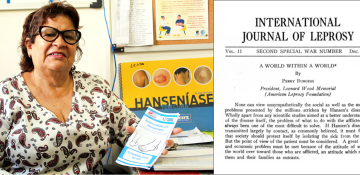Blog: Leprosy versus Hansen’s disease

Author

Marion Jørgensen - Student Volunteer
The term “leprosy” has a long history of use but today many people prefer to use the more official term “Hansen’s disease”. I first learned about leprosy without knowing there was an alternative term for the condition. When I discovered that in some contexts people call it Hansen’s disease, I wondered where this term first originated. In this short text, I investigate how the term leprosy has been used and how the idea of re-labelling the disease as Hansen’s disease developed.
Leprosy’s beginnings
The word “leprosy” derives from the Greek word lepra which means scaly.[i] In the Latin translation of the Bible, the term leprosy is used several times for skin diseases, even though these may not be what we today know as Hansen’s disease. In the Bible, leprosy is represented as God’s punishment of the sinful. This idea is not limited to Judeo-Christianity; many religions and cultures around the world have similar ideas.[ii] People affected by leprosy and similar skin disease in India were considered to be sinners against the sun. In China it was thought that leprosy was sexually transmitted through prostitutes, and it was a punishment for their immoral behaviour. In all of these cases, religious scriptures and beliefs framed leprosy as punishment or a curse.[iii] None of these ideas around leprosy are true, but they persist culturally, making stigmatisation worse for people affected by leprosy.
Hansen’s disease
To disconnect it from its past meanings, a new term, Hansen’s disease, was given to the disease. This name derives from the Norwegian Doctor Gerhard Armauer Hansen, who in 1873, discovered the bacterium known as Mycobacterium leprae as the cause of the disease. As a Norwegian myself, I have been interested in Hansen’s contribution to understanding this disease and his influence. The residents of the National Hansen’s disease centre in Carville, Louisiana advocated for renaming the disease after the discoverer of the bacterium. They had the opinion that words like “leprosy” and “leper” were unjustly associated with uncleanliness, and therefore preferred to call their illness Hansen’s disease.[iv] The leprosy patient Stanley Stein created an international publication named The STAR – Radiating the Light of Truth on Hansen’s Disease that had a goal of educating the public on Hansen’s disease, as well as changing the name to Hansen’s disease.
Who walk alone
In 1940, Perry Burgess wrote the book Who Walk Alone that told the story about a person affected by leprosy. This book was translated into over 50 languages and won the Bookseller Discovery Award of the National Book Award for Nonfiction. Burgess was the head of a fundraising organisation for leprosy named Leonard Wood Memorial, and it was at a conference in 1931 that they suggested the shift in terminology from leprosy to Hansen’s disease.[v] In Who Walk Alone Burgess expressed his opinion that the best way to fight stigma would be to change the name to Hansen’s disease. This book was influential in raising awareness of the stigmatising potential of the term leprosy and set in motion that Hansen’s disease became the more official term.
Reflection
The move from leprosy to Hansen’s disease has not been completely adopted, and leprosy is still more widely used. On the WHO website, they write Leprosy as the title with Hansen’s disease in parentheses. If we are fully to move away from the past, it should be the other way around, with leprosy in parenthesis. This would acknowledge the stigmatising role of the word leprosy. But to get rid of the term leprosy fully would take a lot of time, money and effort and might not even be possible. It might not even be worth it, because people’s perception of the disease itself is what is associated with stigma. A country like Brazil that has made a complete shift to the term Hansen’s disease in official policy, still has stigma related to it. Because leprosy is a more widely known term, it can be useful for many NGOs like NLR to raise funds and resources to fight stigma and discrimination.
Voluntarily written for nlrinternational.org by Marion Jørgensen. Opinions stated in the article are on personal title of the author and do not necessarily express NLR’s views.
Sources
[i] Michael W. Dols, Leprosy in Medieval Arabic Medicine, Journal of the History of Medicine and Allied Sciences, Volume 34, Issue 3, July 1979, Pages 314–333,
[ii] Silatham Sermrittirong and Wim H. Van Brakel, Stigma in leprosy: concepts, causes and determinants, Leprosy Review 85:1 (2014):36-47.
[iii] Solomon Raju M., P. S. Sundar Rao and Karthikeyan G., Socio-medical perspectives on leprosy in Indian religions Leprosy Review 90 (2020):190-99.
[iv] G. H. Faget, The Story of the National Leprosarium: The United States Marine Hospital, Carville, Louisiana, Public Health Report (1896-1970) 61:52 (1946)
[v] Perry Burgess, A world within a world, International Journal of Leprosy 11 (1943)